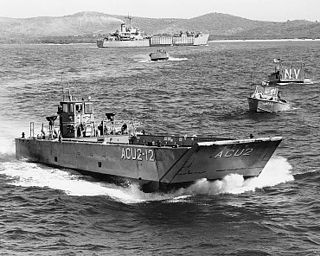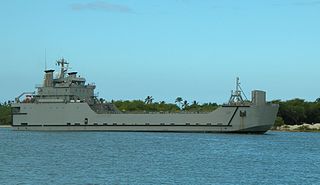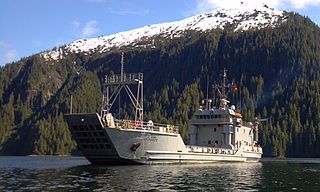The United States Navy, United States Coast Guard, and United States National Oceanic and Atmospheric Administration (NOAA) use a hull classification symbol to identify their ships by type and by individual ship within a type. The system is analogous to the pennant number system that the Royal Navy and other European and Commonwealth navies use.

The Tarawa class is a ship class of Landing Helicopter Assault (LHA) type amphibious assault ships operated by the United States Navy (USN). Five ships were built by Ingalls Shipbuilding between 1971 and 1980; another four ships were planned, but later canceled; instead they were joined by the Wasp-class amphibious assault ships.

USS New Orleans (LPD-18), a San Antonio-class amphibious transport dock, is the fourth commissioned ship of the United States Navy to be named after the city of New Orleans, Louisiana.

The Albion-class landing platform dock is a class of amphibious warfare ship in service with the Royal Navy. The class consists of two vessels, HMS Albion and HMS Bulwark, ordered in 1996 to replace the ageing Fearless class. Both ships were built by BAE Systems Marine at the former Vickers Shipbuilding and Engineering yard in Barrow-in-Furness. Albion was commissioned in 2003 and Bulwark in 2004. Each of the ships has a crew of 325 and can accommodate up to 405 troops. Thirty-one large trucks and thirty-six smaller vehicles and main battle tanks can be carried inside the vehicle deck. To disembark troops and vehicles, the vessels are equipped with eight landing craft. As of 2024, both vessels were in reserve.

The LCM-8 is a river boat and mechanized landing craft used by the United States Navy and Army during the Vietnam War and subsequent operations. They are currently used by governments and private organizations throughout the world. The acronym stands for "Landing Craft Mechanized, Mark 8".

The Landing Craft, Tank (LCT) was an amphibious assault craft for landing tanks on beachheads. They were initially developed by the Royal Navy and later by the United States Navy during World War II in a series of versions. Initially known as the "tank landing craft" (TLC) by the British, they later adopted the U.S. nomenclature "landing craft, tank" (LCT). The United States continued to build LCTs post-war, and used them under different designations in the Korean and Vietnam Wars.

A landing ship, tank, (LST) is a ship first developed during World War II (1939–1945) to support amphibious operations by carrying tanks, vehicles, cargo, and landing troops directly onto a low-slope beach with no docks or piers. The shallow draft and bow doors and ramps enabled amphibious assaults on almost any beach.

A Landing Craft Utility (LCU) is a type of boat used by amphibious forces to transport equipment and troops to the shore. They are capable of transporting tracked or wheeled vehicles and troops from amphibious assault ships to beachheads or piers.

General Frank S. Besson-class logistics support vessels (LSV) are the largest powered watercraft in the United States Army, and are designed to give the Army a global strategic capability to deliver its vehicles and cargo.

An amphibious assault ship is a type of warship employed to land and support ground forces on enemy territory during an armed conflict. The design evolved from aircraft carriers converted for use as helicopter carriers. Modern designs support amphibious landing craft, with most designs including a well deck. Like the aircraft carriers they were developed from, some amphibious assault ships also support V/STOL fixed-wing aircraft and have a secondary role as aircraft carriers.

A heavy-lift ship is a vessel designed to move very large loads that cannot be transported by normal ships. They are of two types:

USS Whetstone (LSD-27) was a Casa Grande-class dock landing ship of the United States Navy. She was named in honor of Whetstone Point, at end of peninsula between the old Basin of downtown Baltimore. The peninsula which also later contained the residential communities of South Baltimore, Federal Hill and Locust Point is bordered by the |Northwest Branch and the Middle and Ferry Branches on the Patapsco River, which is also Baltimore Harbor. Location of Revolutionary War fortifications of Fort Whetstone from the 1770s and the previous site of later Fort McHenry reconstructed beginning in 1798 was named for James McHenry, third Secretary of War under Presidents George Washington and John Adams. The star-shaped fort which defended Baltimore, Maryland from British assault with a two-day bombardment in 12–14 September 1814, during the War of 1812. The poem "Defence of Fort McHenry" when set to music inspired the national anthem, "The Star-Spangled Banner" written as a poem by Francis Scott Key from an off-shore truce ship downriver.

The Casa Grande class was a class of dock landing ships used by the Royal Navy and the United States Navy during the Second World War. Nineteen ships were planned, but two, USS Fort Snelling and USS Point Defiance were cancelled before being completed.

The United States Army Vessel Malvern Hill is a Landing Craft Utility of the Runnymede class. Though currently assigned to the 481st Transportation Company, which is headquartered in Port Hueneme, California, the craft is berthed in Tacoma, Washington. The vessel's namesake is the battle of Malvern Hill in the U.S. Civil War.

Mk III LCU class vessels were follow on class of Mk II LCU operated by the Indian Navy and were meant to augment the Indian Navy's amphibious capability. The ships were deployed for maritime roles like maritime security, beaching, un-beaching, humanitarian relief operations and evacuation from distant islands, search and rescue operations and peace-keeping missions. The landing craft were meant for use by amphibious forces to transport equipment and troops to the shore. They were capable of transporting tracked or wheeled vehicles and troops from amphibious assault ships to beachheads or piers. The landing craft were carried on board amphibious assault ships to the objective area. Built and delivered between 1986-87 the mission of the LCU was to land/retrieve personnel and equipment during amphibious operations. LCU's help land personnel and equipment after the initial assault waves of an amphibious operation.

LCU-2001-class utility landing craft is a class of utility landing craft of the Japan Maritime Self-Defense Force. Two craft were constructed in the 1980s.

USAV General Frank S. Besson Jr.(LSV-1) is the lead ship of the General Frank S. Besson Jr.-class roll-on/roll-off of US Army.
















